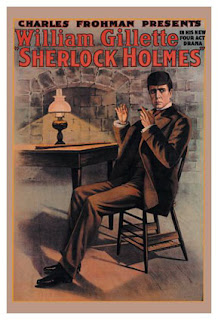Gillette came from Connecticut, where his father was a crusader for a number of causes--among them abolition--and his mother who was descended from Puritan leaders. And before you jump on that, it was the Puritans who brought intellectual depth to the country from England... as well as a number of other things.
Gillette began an apprenticeship as an actor at a young age, coming in contact with Mark Twain. Twain became his mentor. he was not immediately successful; it wasn't until he was 28 that a job with the Frohman brothers allowed him to incororpate skills as a playwright, actor, and director (at low pay). But his first production carrying all three roles was enough of a success that he co-authroed another with the famous novelist Frances Hodgson Burnett, author of The Secret Garden, The Little Princess, and Little Lord Fauntleroy, some of which titles ought to be familiar.
Wikipedia notes that Gillette is best known for his inventions to the world of theatre (I disagree!), but these include "realistic stage settings, and special sound and lighting effects." He also wrote about realism as a style of acting and staging, articulating for the American theatre what the European theatre already knew--which is not a bad thing. Typically, during Gillette's lifetime American theatre lagged the Europeans in staging avant-garde styles--which realism was, at that time.
Gillette came to international success as the playwright and lead actor in The Secret Service and Sherlock Holmes, in the mid- to late-1890s.
And this is where I came in. My presentation was about Gillette's "creation" of Holmes as an enduring and iconographic character. Gillette co-authored--or authored, depending on how you slice it--the first successful Sherlock Holmes performance script (mixing 7 different stories); his co-writer, perhaps, was Arthur Conan-Doyle himself. Gillette was the first actor to use/wear the deerstalker, the Inverness cape, the bent pipe, to use the words "Elementary" and "Hunt's afoot!" I researched and wrote about Gillette's creation of Holmes as a character on paper, but more importantly on stage: the start of a character image used by scores of actors and writers since, including the most recent actors Downey, Syder, and Cumberbatch.
The crux of my paper was the development of this character by Gillette, and its subsequent development by other actors, films, playwrights, TV writers, comic books, and fanzines... The immediate image of the detective has become incredibly pervasive in our culture, affecting writers like Chandler, Hammett, Grafton, Crais, and Child.
















Sherlock Holmes is one of my favorite topics. You only have to get two Sherlockians together and mention the Meerschaum pipe, and immediately the discussion goes to Gillette and the alterations on the character that Conan Doyle allowed him to make. While I am familiar with the cry "The Game's afoot", I don't recognize the expression "Hunt's afoot!", since I have never actually read any of the plays. It is rumored that Charlie Chaplin was the actor who played a Baker Street Irregular to Gillette's Holmes.
ReplyDelete